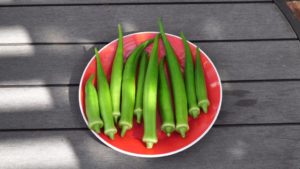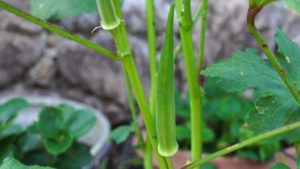My love for this green vegetable brings back fine memories, it definitely warrants a trip down the memory lane. There was never a dull moment at the dinner table when okra was served in our family, all of us used to sprint, it was a mad dash to the dinner table when our mom announced she made okra for dinner.
 |
Nombo Giant Okra |
Nothing could impair our appetites, discussions between bites and fits of constant giggling at the table was rare as all of us savored the veggie. The okras would quickly disappear from the gravy and the last/lazy ones who made it to the table would be left wondering if the okras decided to stage a walk out.
 |
Okra harvest |
Okra is also known as ladies finger or gumbo in some parts of the world. I know many people who avoid okra due to its sliminess, well the good news is it can be avoided if cooked /prepared properly. It is essential you wash and then pat dry the okra before chopping, you should never wash okras after chopping. Saut? them in oil, try not to overcook it and adding a tsp of lemon juice or yoghurt also helps reduce the slime. Here we will describe our experiences in growing and harvesting the green vibrant Nombo Giant okra variety straight from our backyard.
We started our okra seeds indoors in the month of January/February in Southern California, Zone 10. Ensure you start seeds 4-6 weeks before the last frost date in your area. If you are planning on directly sowing the seeds outdoors you have to wait till temperatures reach about 65-70 F. Water the seedlings twice a day till they grow few leaves, after which you can water once every 1-2 days depending on the weather.
 |
Okra plant |
In the month of March, our plants have grown 4 inches tall. This is a good time to transplant seedlings into a larger container. We are using a whiskey barrel container which is 22 inches in diameter, you can buy them at your local garden store like Lowes, Home Depot or even Costco. The soil mix that we have used is a standard potting mix of 30% peat moss, 30% compost, 30% manure and 10% worm castings. This should provide enough nutrition for the seedlings to grow for a few weeks but it?s highly recommended that you use a liquid fertilizer like fish/seaweed emulsion mix, an all-purpose fertilizer or Tomato/vegetable fertilizer every 3 weeks to nurture your plants. When watering your plants, mix liquid fertilizer in and spray foliage and soil till it?s moist. You also want your soil to be well draining, when you first set up the container for the first time you may notice it?s not draining very well, that is normal since it?s absorbing all the moisture it needs but eventually it should drain well.
In the month of April, we noticed our plants were not growing rapidly since we had an unusually cold March/April in our area. Okra?s love hot temperatures, daytime temperatures in the 70?s F and nighttime temperatures in the 65-70 F range is ideal for okras to thrive
By June, our plants showed a lot of vigor in its growth and not surprisingly we were able to harvest our first pods. You will notice that once the warm weather kicks in, that is when you have hot days and warm nights the okra grows and produces pods rapidly. Okra pods of the Nombo Giant variety which are native to the Philippines are big in size compared to the other okra varieties we have grown. June and July are typically the harvest season if you start your plants early.
 |
Okra plant |
Harvest pods when they are green, vibrant in color and tender. Okras are a prolific plant and they keep producing more pods as you harvest. This variety in particular is a big producer and we were able to harvest decent amount of pods every time during the harvest season.
If you used fertilizer at the time of planting now is a good time to replenish your soil and reapply fertilizer. Since temperature are hot make sure you are watering your Okra plants well otherwise they will wilt. Since containers drain quickly, depending on the potting mix you used you may need to water the plants regularly. If you used compost it will retain lot of moisture but if you used a standard potting mix described above you will need to water your containers every day. If it?s not too hot, it is okay to water them once every 2 or 3 days. Establishing a good watering schedule preferably drip irrigation is essential to your plant?s growth.
This plant/seed variety is non GMO and is native to the Philippines. The seed are available on amazon. Here is a link: Okra Seeds
And for those who are still hesitant to try okras, here are a few health benefits of okra. It is rich in Vitamin A, B, C, E and K as well as calcium, iron, magnesium, potassium and zinc. It boosts your immune system, aids in improving digestion, good for your cardiovascular system and protects your eyes against macular degeneration.
Watch our video on growing this wonderful okra variety
Happy Gardening!



Hey i need curry patta plant seeds .. Is there a way you could send them over . Could you shoot me an email i can reply you with my address. I'm very exited to try planting vegs this season . Your videos are very helpful . Thanks shireen. Khan.shireen@yahoo.com
Please tell us where can I buy this (and other vegetable plants/seeds etc.)
https://youtu.be/wPAO9q0NQeE isn't this your video? Someone re uploaded them.
Hi,
I follow your YouTube channel regularly. I heard that you get approximately 1 okra per day per plant. Is this true?
Hi.Was listening to your vedeo about growing curryleaf plant.Please can you send some curry leaf plant seeds.Please email the cost etc.
Where do you get your nombo giant okra seeds from?